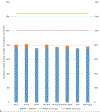Trends Over Time and Jurisdiction Variability in Supplemental Security Income and State Supplementary Payment Programs for Children With Disabilities
- PMID: 32004222
- PMCID: PMC7268284
- DOI: 10.1097/PHH.0000000000001122
Trends Over Time and Jurisdiction Variability in Supplemental Security Income and State Supplementary Payment Programs for Children With Disabilities
Abstract
Context: Nearly 1.2 million children with disabilities received federally administered Supplemental Security Income (SSI) payments in 2017. Based on a robust review of research and evaluation evidence and microsimulations, The National Academies of Sciences, Engineering, and Medicine committee identified modifications to SSI (ie, increasing the federal SSI benefit maximum by one-third or two-thirds) as 1 of 10 strategies that could reduce the US child poverty rate, improving child health and well-being on a population level.
Objective: Describing the availability and amount of SSI and State Supplementary Payment (SSP) program benefits to support families of children with disabilities may be a first step toward evaluating The National Academies of Sciences, Engineering, and Medicine-proposed modification to SSI as a potential poverty alleviation and health improvement tool for children with disabilities and their families.
Design: We used public health law research methods to characterize the laws (statutes and state agency regulations) governing the federal SSI program and SSP programs in the 50 states and District of Columbia from January 1, 1996, through November 1, 2018.
Results: The number of jurisdictions offering supplementary payments (SSP) was relatively stable between 1996 and 2018. In 2018, 23 US jurisdictions legally mandated that SSP programs were available for children. Among the states with SSP payment amounts in their codified laws, SSP monthly benefit amounts ranged from $8 to $64.35 in 1996 and $3.13 to $60.43 in 2018.
Conclusion: Our initial exploration of SSI-related policies as a tool for improving the economic stability of children with disabilities and their families suggests that current SSPs, in combination with SSI, would not rise to the level of SSI increases proposed by The National Academies of Sciences, Engineering, and Medicine. Understanding more about how SSI and SSP reach children and work in combination with other federal and state income security programs may help identify policies and strategies that better support children with disabilities in low-income households.
Conflict of interest statement
Author disclosure statement
The authors declare no conflict of interest.
Figures




Similar articles
-
The TANF/SSI connection.Soc Secur Bull. 2005-2006;66(4):21-36. Soc Secur Bull. 2005. PMID: 17590982
-
A profile of children with disabilities receiving SSI: highlights from the National Survey of SSI Children and Families.Soc Secur Bull. 2005-2006;66(2):21-48. Soc Secur Bull. 2005. PMID: 16878426
-
Trends in Supplemental Security Income Payments to Adults With Autism.Psychiatr Serv. 2020 Jun 1;71(6):602-607. doi: 10.1176/appi.ps.201900265. Epub 2020 Apr 8. Psychiatr Serv. 2020. PMID: 32264799
-
Welfare reform: loss of supplemental security income (SSI) for children with disabilities.J Soc Pediatr Nurs. 1998 Jan-Mar;3(1):33-44. doi: 10.1111/j.1744-6155.1998.tb00207.x. J Soc Pediatr Nurs. 1998. PMID: 9568578 Review.
-
Noncitizens and the Supplemental Security Income program.Soc Secur Bull. 1998;61(4):3-31. Soc Secur Bull. 1998. PMID: 10028553 Review.
Cited by
-
Factors Associated With Bullying Victimization and Bullying Perpetration in Children and Adolescents With ADHD: 2016 to 2017 National Survey of Children's Health.J Atten Disord. 2022 Oct;26(12):1535-1548. doi: 10.1177/10870547221085502. Epub 2022 Apr 5. J Atten Disord. 2022. PMID: 35382621 Free PMC article.
-
Requirements for and Barriers to Rehabilitation Services for Children With Disabilities in Middle- and High-Income Countries: Scoping Review.Interact J Med Res. 2024 Aug 7;13:e50047. doi: 10.2196/50047. Interact J Med Res. 2024. PMID: 39110502 Free PMC article.
-
National and State Trends in autistic Adult Supplemental Security Income Awardees: 2005-2019.J Autism Dev Disord. 2022 Aug;52(8):3547-3559. doi: 10.1007/s10803-021-05215-1. Epub 2021 Aug 18. J Autism Dev Disord. 2022. PMID: 34406587
References
-
- Pascoe JM, Wood DL, Duffee JH, Kuo A, Committee on Psychosocial Aspects of Child and Family Health. Mediators and adverse effects of child poverty in the United States. Pediatrics. 2016;137:e20160340. - PubMed
-
- National Academies of Sciences Engineering and Medicine. A Roadmap to Reducing Child Poverty. Washington, DC: The National Academies Press; 2019. - PubMed
-
- Romig K SSI: A Lifeline for Children with Disabilities. Washington, DC: Center on Budget and Policy Priorities; 2017.
-
- Parish SL, Cloud JM. Financial well-being of young children with disabilities and their families. Soc Work. 2006;51:223–232. - PubMed
Publication types
MeSH terms
Grants and funding
LinkOut - more resources
Full Text Sources
Medical

